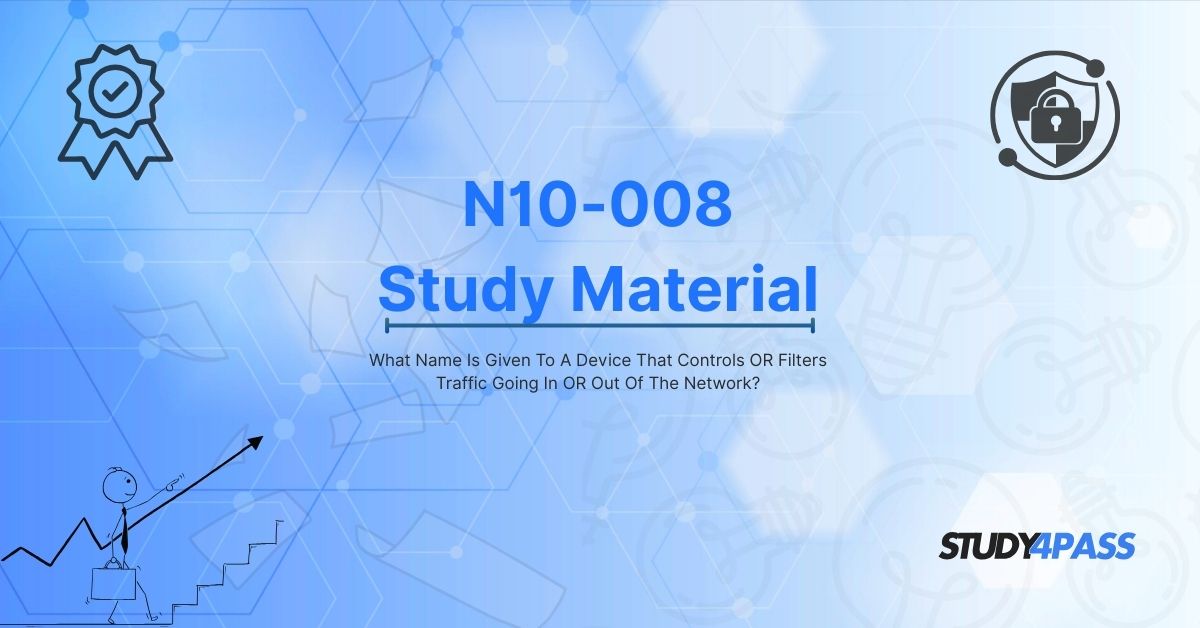Introduction to Network Traffic Control Devices
In modern networking, controlling and filtering traffic is essential for maintaining security, performance, and efficiency. A device that manages traffic entering or exiting a network is known as a firewall. Firewalls play a crucial role in network security by enforcing policies that allow or block data packets based on predefined rules.
For IT professionals preparing for the CompTIA Network+ (N10-008) exam, understanding firewalls and other traffic control mechanisms is vital. This article explores different types of traffic control devices, their functions, and their importance in network security. Additionally, we’ll discuss how Study4Pass provides high-quality study materials to help you ace the CompTIA Network+ certification.
What is a Firewall?
A firewall is a network security device that monitors and filters incoming and outgoing network traffic based on an organization's security policies. It acts as a barrier between a trusted internal network and untrusted external networks, such as the internet.
Types of Firewalls
- Packet-Filtering Firewall
- Examines packets in isolation.
- Uses access control lists (ACLs) to allow or deny traffic.
- Operates at the Network Layer (Layer 3) of the OSI model.
- Tracks the state of active connections.
- More secure than packet-filtering firewalls.
- Operates at the Transport Layer (Layer 4).
- Acts as an intermediary between users and the internet.
- Filters traffic at the Application Layer (Layer 7).
- Provides deep packet inspection (DPI).
- Combines traditional firewall features with advanced security.
- Includes intrusion prevention systems (IPS), malware detection, and application awareness.
- Integrates multiple security features (firewall, antivirus, VPN, etc.).
- Ideal for small to medium-sized businesses.
Other Network Traffic Control Devices
While firewalls are the primary devices for traffic control, other technologies also play a role:
1. Routers with ACLs
- Routers can filter traffic using Access Control Lists (ACLs).
- They operate at Layer 3 and can block or permit traffic based on IP addresses and ports.
2. Intrusion Prevention Systems (IPS) and Intrusion Detection Systems (IDS)
- IDS monitors network traffic for suspicious activity.
- IPS actively blocks detected threats.
3. Load Balancers
- Distributes network traffic across multiple servers.
- Ensures high availability and reliability.
4. Proxy Servers
- Intermediary servers that forward requests on behalf of clients.
- Can cache content and filter web traffic.
Why Understanding Firewalls is Crucial for CompTIA Network+ (N10-008)?
The CompTIA Network+ Certification validates your knowledge of networking concepts, including security and traffic management. Key exam objectives related to firewalls include:
- Security Concepts (1.5) – Firewalls, IDS/IPS, and network segmentation.
- Network Implementations (2.3) – Understanding UTM and NGFW.
- Network Operations (3.2) – Monitoring and optimizing network performance.
- Network Security (4.1, 4.2, 4.3) – Implementing firewalls, VPNs, and secure configurations.
Mastering these topics ensures you can design, implement, and troubleshoot secure networks—a skill highly valued in IT roles.
How Study4Pass Helps You Prepare for CompTIA Network+ (N10-008)?
When preparing for the CompTIA Network+ exam, having the right study materials is essential. Study4Pass offers comprehensive resources, including:
- Detailed Study Guides – Covers all exam objectives, including firewall configurations and network security.
- Practice Tests – Simulates real exam questions to test your knowledge.
- Interactive Labs – Hands-on exercises to reinforce learning.
- Exam Tips & Strategies – Expert advice to maximize your score.
By using Study4Pass, you gain access to structured, Exam-focused content that enhances your understanding of network traffic control devices and other critical topics.
Final Words
A firewall is the primary device responsible for controlling and filtering network traffic, ensuring security and efficiency. For CompTIA Network+ (N10-008) candidates, mastering firewalls and related technologies is essential for passing the exam and excelling in networking careers.
Study4Pass provides the best study materials to help you succeed in your certification journey. With expert-curated content, practice tests, and hands-on labs, you’ll be well-prepared to tackle the exam and advance your IT career.
Start your preparation today with Study4Pass and take the first step toward becoming a certified networking professional!
Special Discount: Offer Valid For Limited Time “CompTIA N10-008 DUMPS”
Sample Questions for CompTIA N10-008 Exam Prep
Actual exam question from CompTIA's N10-008 Exam Materials.
1. Which of the following devices is responsible for filtering and managing network traffic?
a) Modem
b) Firewall
c) Repeater
d) Bridge
2. A security system that monitors and controls incoming and outgoing network traffic is called a:
a) Proxy
b) Firewall
c) Gateway
d) Load Balancer
3. What is the primary function of a firewall in a network?
a) To connect multiple networks
b) To amplify network signals
c) To control and filter traffic
d) To assign IP addresses
4. Which hardware or software acts as a barrier between a trusted network and an untrusted network?
a) VPN
b) Firewall
c) DNS Server
d) NIC (Network Interface Card)
5. A network security device that blocks unauthorized access while permitting authorized communications is known as a:
a) Firewall
b) Switch
c) Hub
d) Repeater


